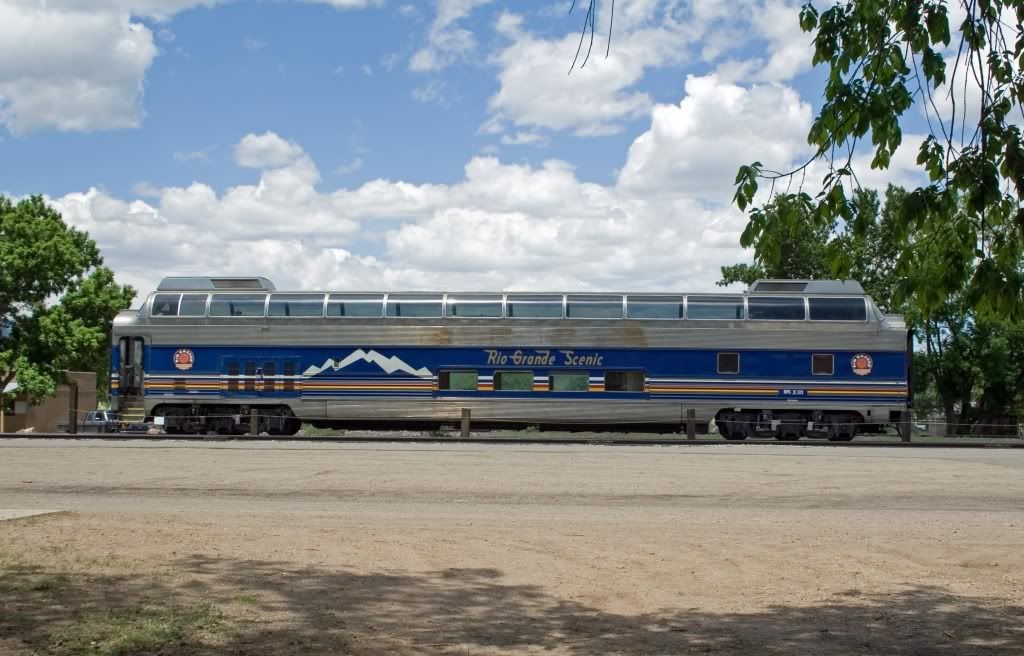It looks like the Rio Grande Ski-train is making a comeback after the Ski-train’s former F40PHs and passenger cars ended up in Canada earlier this year. The ski-train will be pulled by SD9043MACs, an unusual choice for motive power. The SD9043MACs are CITI lease locos, painted in maroon with “Rio Grande” on the long hood.
Am I correct in assuming that Hotel Power for the Ski train consist comes from a genset in one of the cars instead of HEP from a locomotive?
Unless the locomotive is custom-built with a HEP generator buried somewhere under the hood, the power would have to come from a seperate supply.
What does the SL of SLRG represent? (I am guessing that the RG is for Rio Grande)
I’m not sure where the HEP would be placed on a SD9043MAC. With that HUGE Cooling system occupying the rear of the locomotive, I bet there isn’t room.
SLRG: SUPER LARGE RIO GRANDE???
Wow! I thought the Ski Train was gone for good. I wonder now what type of rolling stock will be on this new Ski Train. I hope that it will be corrugated Heritage Fleet Budd cars.
SLRG= San Luis & Rio Grande
Except for Alaska RR’s SD70MACs, I’ve never heard of HEP being on 70-series locos. BNSF’s business cars are pulled by ordinary freight locos too. I guess the new Ski-train passenger cars will have an additional car for HEP power?
If I had to take a guess, I’d have to say that HEP would be drawn off the prime mover.
For example, on NJT’s PL42ACs, part of the 4200 HP is used for HEP, but there’s still quite a bit for traction.
The BNSF cars have a hotel power gen-set in the baggage car that must accompany the train.
The dome cars of the SLRG are electrically self-sufficient. They also have single level passenger cars, but I don’t know how those are powered.

A railfan buddy of mine said he saw this full dome heading west out of Chicago on one of the California trains (likely the CZ with the dome being dropped off at Denver) last week coming through Aurora.

Wow! I thought the Ski Train was gone for good. I wonder now what type of rolling stock will be on this new Ski Train. I hope that it will be corrugated Heritage Fleet Budd cars.
I believe they are the former AOE cars, which if I recall correctly, were all smooth side cars (or at least the bulk of them were). There were some pics floating around on here of the cars in the new paint, but can’t recall which thread.
In regards to the Rio Grande Ski Train: I have the great fortune to work for a couple of weeks each summer at a wilderness camp located at MP93 on the Algoma Central in Ontario, right next to the Montreal Falls bridge [the one that is usually shown in the Canyon Train brochure]. One of the employees was describing to me the orange-yellow passenger train that would sometimes come through. I couldn’t imagine anyone being so color blind as to mistake the Algoma Central silver-gray for yellow. Imagine my surprise one day when, while waiting at our little whistle-stop station,the train that came drifting down the hill was not at all like a Canadian National product, but was indeed yellow and had all of the Ski Train markings on it [were they lost?]. Anyway, a dude that I know from Colorado later told me that the train set had been sold to the AC.
Am I correct in assuming that Hotel Power for the Ski train consist comes from a genset in one of the cars instead of HEP from a locomotive?
A specifications document dated 4/01/09 recommended the following technology to supply electric power to the new Ski Train.
-
Each unit in the locomotive consist is to be equipped with steam generators and connecting steam lines placed beneath the drawbars.
-
A lead combination coach and power car couples to the locomotive. The power compartment (or “engine room”) will have the appropriate piping to accept high pressure steam that first will be routed through a two-cylinder reciprocating steam engine that in turn will power the direct current dynamo that supplies power to the armature of the alternating current main generator.
-
Exhaust steam from the reciprocating steam engine then will be routed through a turbine that will power the main generator, the unit which will cool, heat, and light the train.
-
A condensing unit built into the roof of the combine then captures the exhaust steam from the turbine, transforms the vapor into water, and then additional hoses will return the water to the locomotive for reuse.
-
To enhance a patron’s enjoyment of the journey, each seat will be equipped with a multi-channel sound system. The Bose Corporation of Massachusetts has developed a sophisticated sound capture system that will be placed in the engine room of the combine. Using state-of-the-art digital enhancements, the sound of the two cylinder reciprocating power plant will then be transmitted by electric wire to each passenger’s personal
HAHAHA Well Played!